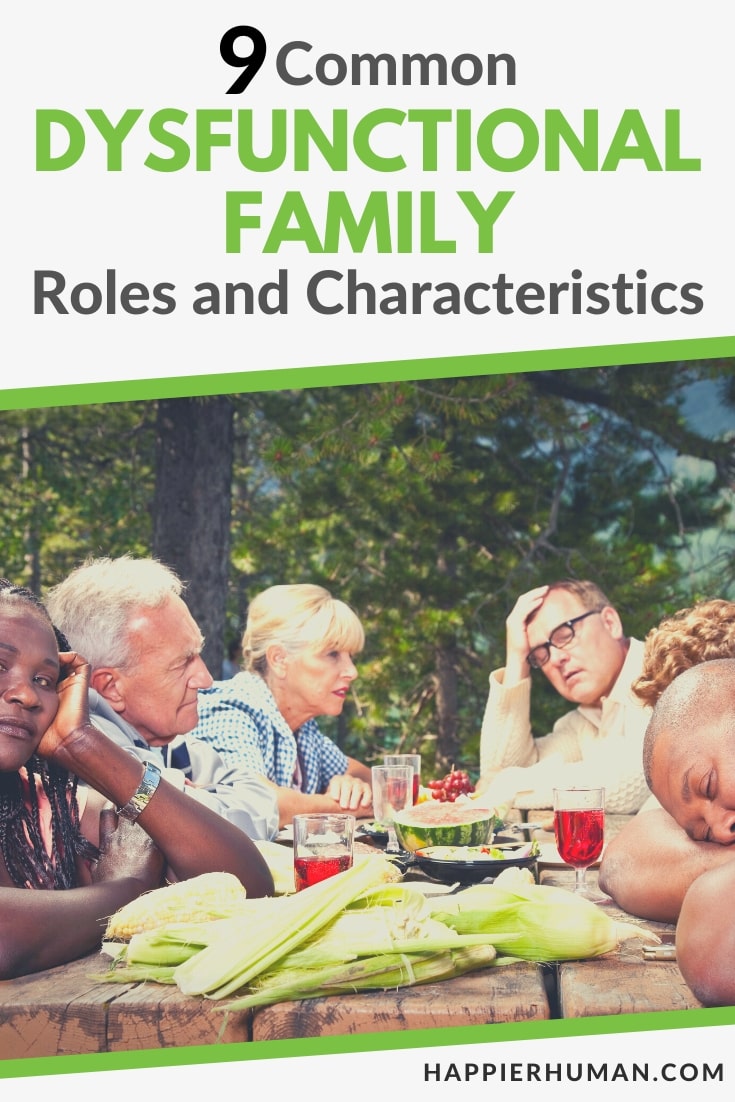There is likely to be affiliate hyperlinks on this web page, which suggests we get a small fee of something you purchase. As an Amazon Affiliate we earn from qualifying purchases. Please do your personal analysis earlier than making any on-line buy.
Each particular person performs a task of their household, whether or not it’s wholesome or dysfunctional. In a typical rapid household, there are the standard roles of mom, father, youngster, and sibling, and once you zoom out, there are the grandparent, aunt, uncle, and cousin roles.
However your household dynamics go manner deeper than that. If your loved ones is dysfunctional, like mine, the roles don’t steadiness one another out or work collectively correctly as they do in a well-oiled wholesome household machine.
As a substitute, dysfunctional household roles trigger harm and confusion, deliver chaos, and trigger upset. The folks in these roles even exhibit codependent or enabling traits, leading to extra dysfunction.
Let’s have a look at the dysfunctional household roles so you’ll be able to study extra and establish whether or not the members of your loved ones match into these or not.
What Does Dysfunctional Imply?
Dysfunctional refers to one thing that doesn’t work or operate because it ought to. For instance, in case your automobile is dysfunctional, it doesn’t function correctly as a result of the engine is damaged or the spark plugs are defective.
The time period “dysfunction” may confer with social conduct that’s not the norm and thought of as unhealthy. When you’re dysfunctional or behave in a dysfunctional manner, you aren’t doing what you must or what’s regular.
What’s Thought-about Dysfunctional in a Household Construction?
A household unit could be dysfunctional, too. It’s a household construction that’s unhealthy and embroiled with battle, animosity, criticism, indifference, hostility, and a lack of construction. It’s crammed with neglect, secrecy, abuse, lack of emotional assist and no empathy, and little or no unconditional love.
A baby’s emotional and bodily wants aren’t met (typically in any respect), and neither are these of the opposite relations.
There are varied elements that may trigger a household to grow to be dysfunctional:
- Poor parenting (generational curse)
- Substance abuse or different kinds of dependancy
- Power bodily sickness
- Poor communication
- Psychological sickness
- Controlling, authoritarian, or manipulative behaviors
- Unlucky life occasions, like divorce, unemployment, monetary misery, or demise
- Insecure attachment kinds
- Social, financial, political, monetary, or cultural instability
Psychologists typically group dysfunctional households into these classes:
- The pathological household: One or each mother and father are dysfunctional due to psychological sickness or abuse. The youngsters are often the adults right here.
- The persistent battle household: Battle, combating, arguments, and disagreements (in addition to stress and resentment) are the norm. The household fights in unhealthy methods, and the house atmosphere is one among excessive hostility.
- The chaotic household (severely-disturbed household): The mother and father abuse or neglect the youngsters so the youngsters aren’t properly looked-after or protected. There are no guidelines or expectations, and inconsistency is the one constant factor.
- The dominant-submissive household (authoritarian household): One or each mother and father are a dictator, and it’s their manner or the freeway. There’s little to no regard for anybody on this household, with meager love efforts, no optimistic reinforcement, and nil assist. Penalties for misbehavior or shortcomings are extreme.
- The emotionally indifferent household: The mother and father don’t present any love, assist, or affection and could be categorised as emotionally unavailable, distant, and chilly. The children suppress their feelings as a result of nobody talks about their emotions – ever – and once they strive, they’re shut down.
Whereas dysfunctional households sometimes fall into one among these classes, nothing is clear-cut. In Anna Karenina, Leo Tolstoy summarized it greatest: “All comfortable households are alike, however each sad household is sad in its personal manner.” And that’s true.
Each dysfunctional household has their personal distinctive manner of being dysfunctional.
I wish to observe that it’s frequent for an unhealthy household to look regular or good to outsiders, however after all, this isn’t at all times the case.
An outsider will solely choose up that the household construction isn’t wholesome when somebody within the household “loses their cool” and the cracks begin to present.
Then again, a wholesome or practical household is one through which everybody loves unconditionally, nurtures, and helps one another.
The household has a wholesome attachment model, and so they work on points in a structured and non-toxic manner. The household is a house, a secure house for everybody to ask questions, really feel what they really feel, and problem the norm.
The Results of Having a Dysfunctional Household
There are varied results of dwelling or rising up in a dysfunctional household. If one of many adults within the household tends to be mentally wholesome, they, too, gained’t have a straightforward dwelling life – identical to the youngsters.
Listed below are the most typical results of getting a dysfunctional household:
- Poor vanity and self-image
- Low self-confidence
- Unhealthy attachment kinds
- Excessive shyness
- Unable to control their feelings or are emotionally unaware
- Poor tutorial or work efficiency as they discover it difficult to focus and focus (or have studying deficits)
- Have interaction in self-destructive conduct, like self-harming
- Liable to dependancy
- Temper issues, conduct issues, and psychological well being diseases, corresponding to nervousness, melancholy, paranoia, suicidal ideas, borderline persona dysfunction, or post-traumatic stress dysfunction
- Irresponsible and harmful or grow to be a goody-two-shoes and excessive rule follower
- Search exterior validation
- Change into withdrawn and socially remoted
- Change into people-pleasers
- Have poor communication and decision-making abilities
9 Widespread Dysfunctional Household Roles and Traits
Listed below are the most typical dysfunctional household roles and traits, however observe that grouping some people into just one class isn’t simple.
These unhealthy household roles are versatile. Oftentimes, one member of the family might match predominantly in a single function however in addition they exhibit traits of one other. Or, they fill one other function if one of many adults (for instance) is not round.
Alternatively, a person can match into one other function once you have a look at bigger or prolonged household dynamics.
1. The Hero
In the event you consider heroes, they’re the nice characters in a present, film, or e-book, so how can “the hero” be a part of a dysfunctional household? Or somewhat, how is the hero additionally a dysfunctional member of the family?
In an unhealthy household unit, the hero appears to be a well-balanced, high-functioning particular person.
They’re the instance used to show the household is doing properly. It’s like this: “Nicely, if daddy Jack is the CEO of a multi-million firm, then the household can’t be so unhealthy” or “If little Suzie is at all times on the high of her class, then our household have to be doing properly, proper?”

It’s all a facade.
The hero (tries to) proves to outsiders that their household is all proper and functioning usually, regardless of the entire household unit being dysfunctional. They’re additionally the people who perceive the poisonous household dynamics higher than anybody else.
If the hero of the household is a baby, they’re typically parentified and tackle the function of an grownup when one of many mother and father is unavailable.
As a baby or grownup, the hero feels the immense stress to maintain up the household’s “wholesome” look and so they typically attempt to resolve familial points.
The important thing traits of the hero are:
- Perfectionistic tendencies
- Extremely accountable
- An overachiever
- Usually overworked
- Selfless
2. The Golden Youngster
The golden youngster is the individual that can do nothing incorrect. They’re the tremendous child who excels at the whole lot, and the mother and father brag and revere this youngster.
For a problematic mother or father, the golden youngster “proves” that the household is doing nice and that the mother or father is an effective particular person (and mother or father) as a result of such an ideal particular person can solely be the product of a supportive, wholesome atmosphere.
For a narcissistic mother or father, the golden youngster represents the whole lot the mother or father loves about themselves.
If the golden youngster has siblings, their mother and father solely have eyes for the tremendous youngsters. All the opposite youngsters are in contrast unfavorably to the golden youngster and located wanting.
The golden youngster makes use of their “goldenness” as an escape path – to get away from the abuse their siblings undergo.
They’ll additionally do something and the whole lot of their energy to do what their mother and father count on and need of them as a result of they worry rejection and abuse (ought to they mess up).
The important thing traits of the golden youngster are:
- By no means rock the boat (“sure and amen” conduct)
- Rule follower
- Overachievers
- Perfectionistic
- Low sense of self
- Obsessively hooked up to others for exterior validation
- Liable to nervous breakdowns
3. The Scapegoat
The scapegoat (typically known as the black sheep, however they’ve completely different roles) is the one that is blamed for the whole lot. It may be that one thing was really their fault, it might be another person’s fault, or perhaps a made-up blame.
A scapegoat is routinely and unfairly blamed for everybody’s issues.
A mother or father or a baby is usually scapegoated. They’re bullied, solid apart, singled out, and ignored, and so they really feel unloved, remoted, and rejected.
If the mother or father(s) is narcissistic, it’s frequent that the golden youngster and scapegoat are pitted towards one another. That is known as splitting and is a type of distraction (from the household’s actual points).
The important thing traits of the scapegoat are:
- Often probably the most emotionally secure within the dysfunctional household
- Are socially awkward
- Change into shells of themselves or exit of their approach to be socially accepted
- Might be troublemakers (as a result of they’re used to the blame and fallout)
4. The Mascot (or Clown)
The household mascot or clown is the person who makes use of humor and goofiness to “deactivate” battle. They typically draw consideration towards themselves and away from the volatility of the second.
The clown may additionally draw consideration away from the abuse that the scapegoat or black sheep suffers with their ridiculous antics or cheeky mischief.

The lightheartedness and evasion techniques merely assist the household sweep their points below the rug, which solely intensifies the toxicity.
As soon as the clown has efficiently defused annoying and unstable conditions a number of instances, they could really feel a lot of stress to crack a joke each time there’s battle.
The important thing traits of the mascot are:
- Very humorous, making jokes and teasing to defuse annoying conditions
- Seem like jovial, despite the fact that they’ve bouts of melancholy and cope with a lot of harm
- Problem coping with battle or connecting with damaging feelings
- Extremely observant about modifications in an individual’s physique language and tone so they’re prepared to leap in with humor (to move off drama)
5. The Black Sheep (or Recognized Affected person or Addict)
The black sheep of the household can also be known as the recognized affected person or the addict. They’re the people whose fault it’s that the household has issues (much like the scapegoat’s).
A black sheep is an outlier – somebody who’s very completely different from the remainder of the household. Maybe they’re the one one that’s left-handed, has darkish hair, or is obese.
Or the black sheep thinks otherwise (has an open thoughts) or doesn’t observe within the household footsteps of working for daddy’s firm. They could even be chronically sick or have a psychological sickness.
The black sheep is both comfortable to stand on their very own and never be like the remainder of the household or they’re determined for approval and love.
They could overcompensate for his or her shortcomings, and to manage, crawl into the bottle, porn, or different self-destructive conduct.
The important thing traits of the black sheep are:
6. The Misplaced Youngster (or the Loner)
The misplaced youngster needs to vanish. They know that being seen equals moving into bother, very similar to their black sheep or scapegoat sibling, or being within the limelight, just like the hero or golden youngster.
In a big household, the loner child is usually the center youngster who simply doesn’t get as a lot consideration as the opposite bunch. However the misplaced youngster could be “misplaced” by alternative too.
They could be very introverted, shy, or delinquent, and they really feel disgrace about their household scenario. If somebody reaches out or provides them consideration, they merely withdraw additional into themselves.
Because the quiet youngster, they like to spend time by themselves, hiding away from their dysfunctional household.
The important thing traits of the misplaced youngster are:
- Loner conduct
- Very unbiased but indecisive
- Steer clear from confrontation
- Attempt to mix in or fade into the background
7. The Caretaker (or Enabler or Martyr)
The caretaker is much like the hero in that they assist keep the looks that the household dynamic is wholesome. Nevertheless, the caretaker is just like the fixer of the household, at all times supporting and affirming the poisonous conduct.
An enabler has a robust sense of accountability and possession to assist the household with their points, and so they do the whole lot they will to preserve everybody comfortable – even when meaning denying the actual points.
A parentified youngster or codependent grownup could be the household’s caretaker, and they’re at all times busy: cleansing, cooking, serving to with schoolwork, or folding laundry. A martyr solely is aware of who they’re when they’re taking care of others and serving to.
The important thing traits of the caretaker are:
- At all times caring for everybody however themselves
- Extremely accountable
- Don’t loosen up simply as they’re hypervigilant, prepared to repair and choose up the items
- Individuals pleasers
8. The Mastermind (or Manipulator)
The mastermind or manipulator is probably the most nefarious of the dysfunctional household roles. They use different folks’s weaknesses and errors to get what they need, whether or not that’s their mother or father’s or sibling’s insecurities or triggers.

They’re masters at directing the scenario to their profit. However they accomplish that covertly by merely pulling strings till their relations dance – simply how they prefer it.
The manipulator switches off their feelings as a coping mechanism. They consider their conduct is justified due to the dysfunctional household dynamics they grew up in.
The important thing traits of the mastermind are:
- Manipulative, gaslighting, and controlling conduct to get what they need
- Grasp strategists and consultants at controlling others
- Lack any sense of guilt or concern for the well-being of others
- Pretends to be good to the world
9. The Peacemaker
The peacemaker is the one who needs everybody to only get alongside as a result of they wish to reside in a contented and peaceable home.
They may both be within the heart of the battle storm, attempting to calm everybody down, or they’ll be baking brownies within the kitchen, fortunately ignorant concerning the battle within the subsequent room.
Mr. or Miss Switzerland may even attempt to make excuses for the poisonous conduct of their relations and brush it apart. They only make the entire dysfunctional dynamic worse as a result of they gaslight and invalidate what everybody feels and experiences.
The “Oh, they didn’t imply that” is a phrase the peacemaker may be very keen on utilizing.
The important thing traits of the peacemaker are:
- At all times in search of options to calm everybody and repair the issue
- Mediates between relations or avoids battle altogether
- Could also be emotionally immature and never expertise emotions like others
Closing Ideas on Dysfunctional Household Roles
It’s by no means simple in terms of navigating the dynamics of an unhealthy household. However when you recognize higher, you’ll be able to do higher.
You possibly can’t change your different relations, however you’ll be able to establish which dysfunctional household function is yours, study to like and forgive your self, and resolve the way you’ll deal with household gatherings (and if leaving or not coming is the best choice for you).
Nonetheless unsure your loved ones is a dysfunctional one? Try these 11 warning indicators so you’ll be able to know for positive, break away from the toxicity, and reside your greatest life.
And if you would like extra articles about household, make sure you try these weblog posts:

